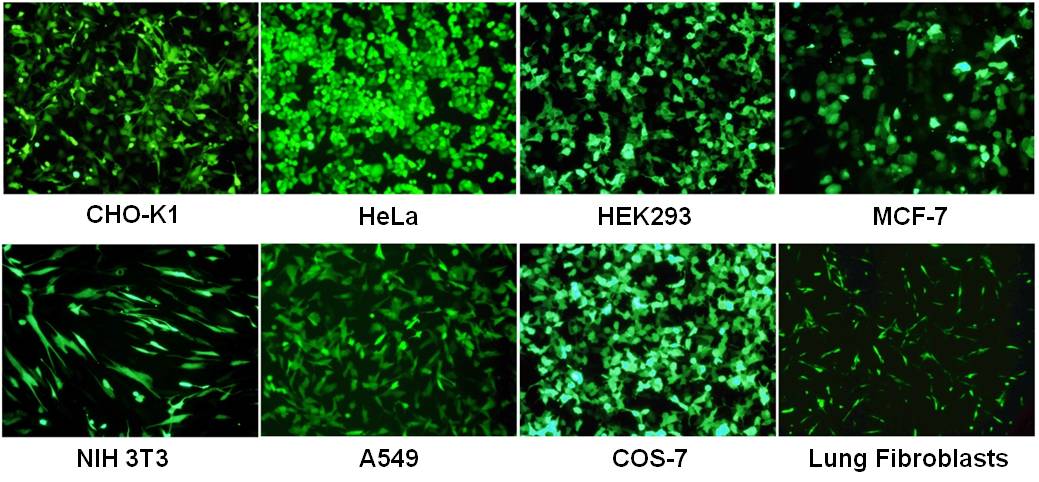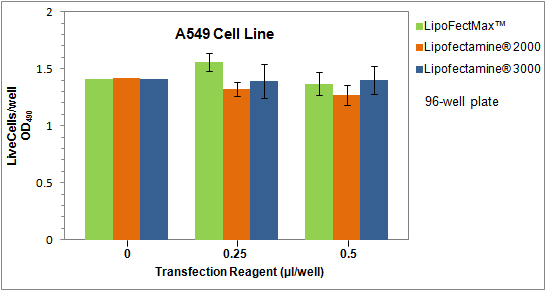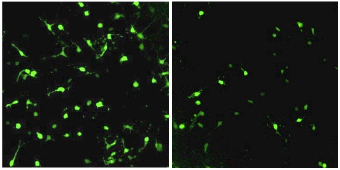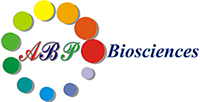LipoFectMax™ Transfection Reagent is a lipid-based transfection reagent that forms a complex with DNA or RNA, and transports the complex into a variety of adherent and suspension cell lines. LipoFectMax™ Transfection Reagent has been tested to work the same efficiency as Lipofectamine® 2000 Reagent, and used for the transfection of both DNA and RNA into eukaryotic cells even in the presence of serum.
Features
- Superior transfection efficiency for a broad range of cell lines
- Does not require removal of serum or culture medium
- Does not require washing or changing of medium after transfection
- Low cytotoxicity

Figure 1. Assessment of LipoFectMax™ transfection efficiencies using GFP visualization. 8 commonly-used cell lines were transfected with a GFP-expressing plasmid using LipoFectMax™ transfection reagent. Cells were visualized 48 hours post-transfection under fluorescence microscopy (GFP filter).

Figure 2. Comparison of cytotoxicity between LipoFectMax™, Lipofectamine® 2000 and Lipofectamine® 3000.

Figure 3. Comparison of LipoFectMax™ and Lipofectamine® 2000 in plasmid transfection on mouse neuronal cells. Mouse neuronal cells were transfected with a GFP-expressing plasmid using either LipoFectMax™ transfection reagent (left), or Lipofectamine® 2000 (right). Cells were visualized 48 hours post-transfection under fluorescence microscopy (GFP filter).
| Protocol (PDF): | FP310 |
| MSDS (PDF): |
MSDS-FP310 MSDS-FP311 |
Cited Reference:
Bioinformatics analysis of LINC01554 and its co‑expressed genes in hepatocellular carcinoma
Li, L., Huang, K., Lu, Z., Zhao, H., Li, H., Ye, Q., & Peng, G.
Oncology Reports, 2020, 44, 2185-2197. https://doi.org/10.3892/or.2020.7779
Sesterterpene MHO7 suppresses breast cancer cells as a novel estrogen receptor degrader
Yue Zhao, Chenxi Zhao, Jin Lu, Jun Wu, Changhao Li, Zhiye Hu, Wei Tian, Liang Yang, Jin Xiang, Haibin Zhou, Zixin Deng, Jian Huang, Kui Hong
Pharmacological Research, 2019, 146, 104294, https://doi.org/10.1016/j.phrs.2019.104294
Generation of C-to-G transversion in mouse embryos via CG editors
Cao, T., Liu, S., Qiu, Y. et al.
Transgenic Res 31, 445–455 (2022). https://doi.org/10.1007/s11248-022-00313-x
RIPK3 Promotes JEV Replication in Neurons via Downregulation of IFI44L
Bian P, Ye C, Zheng X, Luo C, Yang J, Li M, Wang Y, Yang J, Zhou Y, Zhang F, Lian J, Zhang Y, Jia Z and Lei Y
Front. Microbiol. 2020, 11:368. doi: 10.3389/fmicb.2020.00368
Stanniocalcin 2 Is Upregulated by Calcium-Sensing Receptor and Protects Human Vascular Smooth Muscle Cells from High-Phosphate-Induced Apoptosis
Liu F, Zhang A, Huang H, Liu X, Diao Z, Deng D, Liu W
Cardiorenal Med 2022;12:214-228. doi: 10.1159/000527441
STC2: A Novel and Regulable Protector of Vascular Smooth Muscle Cells
Zhang, Ai-hua and Liu, Fen-fen and Huang, Hong-dong and Liu, Xu and Diao, Zong-li and Deng, Dai and Liu, Wen-hu
http://dx.doi.org/10.2139/ssrn.4010831
Axl-/- neurons promote JEV infection by dampening the innate immunity
Jiali Yang, Mengyuan Li, Mingcheng Yuan, Peiyu Bian, Yangchao Dong, Haijun Zhang, Chuanyu Luo, Zhifeng Xue, Yuan Wang, Fanglin Zhang, Lixin Shen, Yingfeng Lei
Virus Research, 2022, 307, 198605, https://doi.org/10.1016/j.virusres.2021.198605
Endothelial and systemic upregulation of miR-34a-5p fine-tunes senescence in progeria.
Manakanatas C, Ghadge SK, Agic A, Sarigol F, Fichtinger P, Fischer I, Foisner R, Osmanagic-Myers S.
Aging (Albany NY). 2022 Jan 12;14(1):195-224. doi: 10.18632/aging.203820
A novel homozygous RIPK4 variant in a family with severe Bartsocas-Papas syndrome
Dinçer, T., Gümüş, E., Toraman, B., Er, Yildiz, G., Yüksel, Z., & Kalay, E.
Am J Med Genet. 2021;185A:1691–1699. doi:10.1002/ajmg.a.62154
Comprehensive Pan-Cancer Analyses of Immunogenic Cell Death as a Biomarker in Predicting Prognosis and Therapeutic Response.
Wang, Y.; Huang, Y.; Yang, M.; Yu, Y.; Chen, X.; Ma, L.; Xiao, L.; Liu, C.; Liu, B.; Yuan, X.
Cancers 2022, 14, 5952. https://doi.org/10.3390/cancers14235952
Hydroxychloroquine impairs mTORC1-dependent cholesterol biosynthesis and sensitizes retinal pigment epithelial cells to UV-induced cell death
I Wicks, ML Kim, D De Souza, V Narayana, N Nguyen
Research Square, 2022, https://doi.org/10.21203/rs.3.rs-2299218/v1
PTPRH Alleviates Airway Obstruction and Th2 Inflammation in Asthma as a Protective Factor
Feng-jia Chen, Li-juan Du, Zhimin Zeng, Xin-yan Huang, Chang-yi Xu, Wei-ping Tan, Can-mao Xie, Yu-xia Liang & Yu-biao Guo
Journal of Asthma and Allergy, 2022, 15: 133-144. DOI: 10.2147/JAA.S340059
Human cytomegalovirus pUL97 upregulates SOCS3 expression via transcription factor RFX7 in neural progenitor cells
Xian-Zhang Wang, Le Wen, Yue-Peng Zhou, Sheng-Nan Huang, Bo Yang, Shuang Cheng, Wen-Bo Zeng, Meng-Jie Mei, Jin-Yan Sun, Xuan Jiang, Han Cheng, Min-Hua Luo
PLoS Pathog 2023, 19(2): e1011166. https://doi.org/10.1371/journal.ppat.1011166
Comprehensive Pan-Cancer Analyses of Immunogenic Cell Death as a Biomarker in Predicting Prognosis and Therapeutic Response.
Wang, Y.; Huang, Y.; Yang, M.; Yu, Y.; Chen, X.; Ma, L.; Xiao, L.; Liu, C.; Liu, B.; Yuan, X.
Cancers 2022, 14, 5952. https://doi.org/10.3390/cancers14235952

